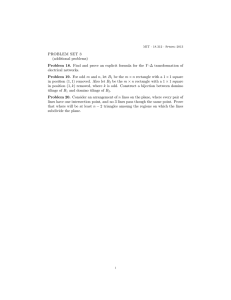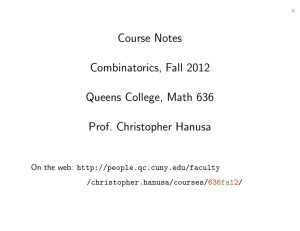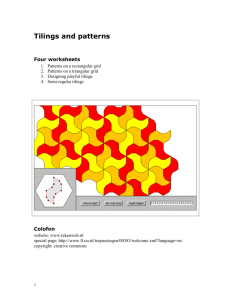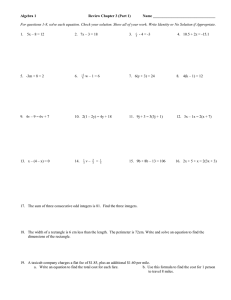#A52 INTEGERS 10 (2010), 697-703 COMBINATORIAL INTERPRETATIONS OF BINOMIAL
advertisement
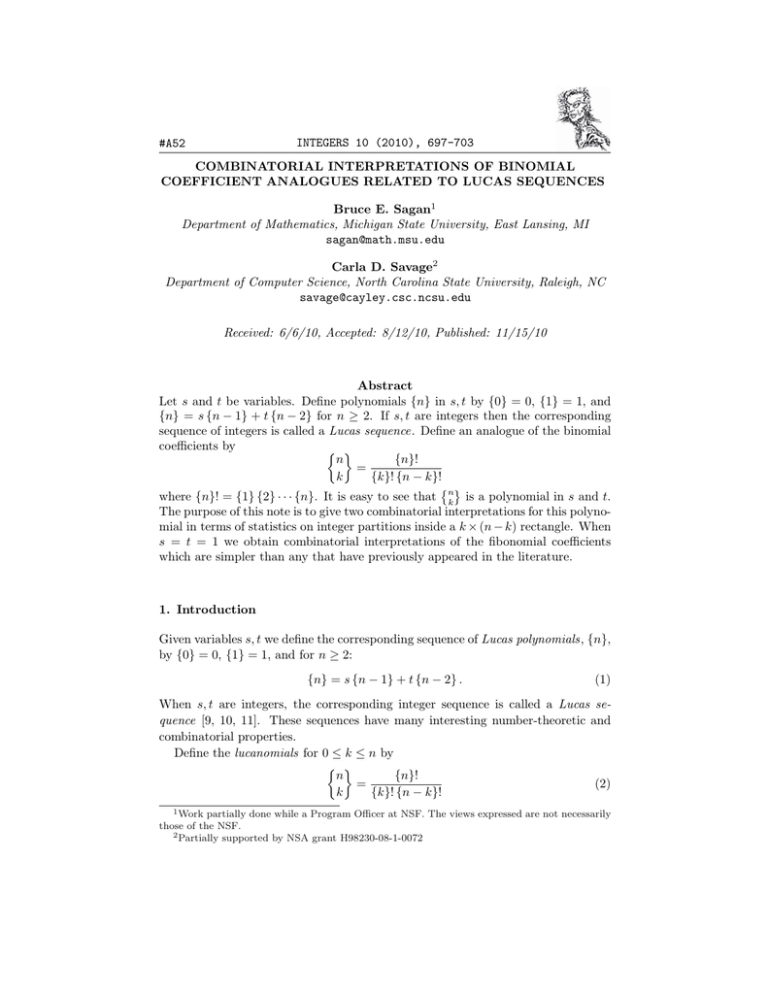
INTEGERS 10 (2010), 697-703
#A52
COMBINATORIAL INTERPRETATIONS OF BINOMIAL
COEFFICIENT ANALOGUES RELATED TO LUCAS SEQUENCES
Bruce E. Sagan1
Department of Mathematics, Michigan State University, East Lansing, MI
sagan@math.msu.edu
Carla D. Savage2
Department of Computer Science, North Carolina State University, Raleigh, NC
savage@cayley.csc.ncsu.edu
Received: 6/6/10, Accepted: 8/12/10, Published: 11/15/10
Abstract
Let s and t be variables. Define polynomials {n} in s, t by {0} = 0, {1} = 1, and
{n} = s {n − 1} + t {n − 2} for n ≥ 2. If s, t are integers then the corresponding
sequence of integers is called a Lucas sequence. Define an analogue of the binomial
coefficients by
! "
n
{n}!
=
k
{k}! {n − k}!
# $
where {n}! = {1} {2} · · · {n}. It is easy to see that nk is a polynomial in s and t.
The purpose of this note is to give two combinatorial interpretations for this polynomial in terms of statistics on integer partitions inside a k × (n − k) rectangle. When
s = t = 1 we obtain combinatorial interpretations of the fibonomial coefficients
which are simpler than any that have previously appeared in the literature.
1. Introduction
Given variables s, t we define the corresponding sequence of Lucas polynomials, {n},
by {0} = 0, {1} = 1, and for n ≥ 2:
{n} = s {n − 1} + t {n − 2} .
(1)
When s, t are integers, the corresponding integer sequence is called a Lucas sequence [9, 10, 11]. These sequences have many interesting number-theoretic and
combinatorial properties.
Define the lucanomials for 0 ≤ k ≤ n by
! "
n
{n}!
=
(2)
k
{k}! {n − k}!
1 Work partially done while a Program Officer at NSF. The views expressed are not necessarily
those of the NSF.
2 Partially supported by NSA grant H98230-08-1-0072
INTEGERS: 10 (2010)
698
# $
where {n}! = {1} {2} · · · {n}. It is not hard to show that nk is a polynomial in
s and t. (This follows from Proposition 2 below). The purpose of this note is to
give two simple combinatorial interpretations of the lucanomials. They are based
on statistics associated with integer
#n$ partitions λ inside a k ×(n−k) rectangle. More
specifically, we will show that k is the generating function for certain tilings of
such λ and their complements with dominos and monominos.
Various specializations of the parameters s and t# are
$ of interest. When s =
t = 1, {n} becomes the nth Fibonacci number, and nk is known as a fibonomial
coefficient. Gessel and Viennot [7] gave an interpretation of the fibonomials in
terms of nonintersecting lattice paths and asked for a simpler one. Benjamin and
Plott [2] gave another interpretation in terms of tilings, but it is not as straightforward as ours. When s = " and t = −1 we get two new interpretations of the
"-nomial coefficients of Loehr and Savage [8]. This case is of interest because of its
connection with the Lecture Hall Partition Theorem introduced by Bousquet-Mélou
and (Kimmo) Eriksson [4, 5, 6]. Finally, letting s = q + 1 and t = −q one gets new
interpretations for the classical q-binomial coefficients. For more information about
these important polynomials, see the text of Andrews [1].
We should mention that it is possible to derive our results from q-binomial coefficient identities using algebraic manipulations, analogous to what is done for
"-nomial coefficients in Section 3.3 of [8]. However, we wish to demonstrate how
these results follow from simple, combinatorial arguments.
2. Recursions
In this section we will present the recurrence relations we will need for our combinatorial interpretations. To obtain these results, we will use a tiling model that
is often useful when dealing with Lucas sequences. See the book of Benjamin and
Quinn [3] for more details. Suppose we have n squares arranged in a 1×n rectangle.
We number the squares 1, . . . , n from left to right and also number the vertical edges
of the squares 0, . . . , n left to right. A linear tiling, T , is a covering of the rectangle
with disjoint dominos (covering two squares) and monominos (covering one square).
Let Ln be the set of all such T . The tilings in L3 are drawn in Figure 1 where a
dot in a square represents a monomino while two dots connected by a horizontal
line represent a domino.
Let the weight of a tiling be w(T ) = sm td where m and d are the number of
monominos and dominos in T , respectively. We will use the same weight for all
other types of tilings considered below. Since the last tile in any tiling must be
699
INTEGERS: 10 (2010)
L3
:
{4} =
!
!
s3
!
!
+
!
!
st
+
!
!
st
!
Figure 1: The tilings in L3 and corresponding weights
a monomino or domino, the initial conditions and recursion (1) immediately give
%
{n + 1} =
w(T ).
T ∈Ln
See Figure 1 for an illustration of the case n = 3.
For our second combinatorial interpretation, we will need another sequence of
polynomials closely related to the {n}. Define %n& using recursion (1) but with the
initial conditions %0& = 2 and %1& = s. If s = t = 1 then %n& is the nth Lucas number.
A combinatorial interpretation for these polynomials is obtained via another type
of tiling. In a circular tiling of the 1 × n rectangle, the edges labeled 0 and and n
are identified so that it is possible to have a domino crossing this edge and covering
the first and last squares. Such a domino, if it exists, will be called the circular
domino of the tiling. Let Cn be the set of circular tilings of a 1 × n rectangle. So
Ln ⊆ Cn is the subset of all circular tilings with no circular domino. For example,
C3 consists of the tilings in L3 displayed previously together with
!
Now for n ≥ 1 we have
%n& =
!
%
!
.
w(T ).
(3)
T ∈Cn
Indeed, to show that the sum satisfies (1) first note that we already have a weightpreserving bijection for the linear tilings involved. And if T ∈ Cn has a circular
edge, then removal of the tile covering square n − 1 will take care of the remainder.
In order to make (3) also hold for C0 , we give the empty tiling # of the 1 × 0 box
weight w(#) = 2. Bear in mind that # considered as an element of L0 still has
w(#) = 1. Context will always make it clear which weight we are using.
We start with two recursions for the Lucas polynomials. These are well known
for Lucas sequences; see [3, p. 38, Identity 73] for (4) and [3, p. 46, Identity 94]
or [10, p. 201, Equation 49] for (5). Also, the proofs in the integer case generalize
to variable s and t without difficulty. But we will provide a demonstration for
completeness and to emphasize the simplicity of the combinatorics involved.
700
INTEGERS: 10 (2010)
Lemma 1. For m ≥ 1 and n ≥ 0 we have
{m + n} = {n + 1} {m} + t {m − 1} {n} .
(4)
For m, n ≥ 0 we have
{m + n} =
%n&
%m&
{m} +
{n} .
2
2
(5)
Proof. For the first identity, the left-hand side is the generating function for T ∈
Lm+n−1 . The second and first terms on the right correspond to those tilings which
do or do not have a domino crossing the edge labeled n, respectively. To illustrate,
if m = n = 2 then the tilings in Figure 1 are counted by {m + n}. The first two
tilings do not have a domino crossing the edge labeled 2 and so are counted by
{n + 1} {m}. The edge of the third tiling does cross that edge and is counted by
t {m − 1} {n}.
Multiply the second equation by 2 and consider two copies of Lm+n−1 . In each
tiling in the first copy distinguish the edge labeled m − 1, and do the same for the
edge labeled m in the second copy. The set of tilings in both copies where a domino
does not cross the distinguished edge accounts for the terms corresponding to linear
pairs in %n& {m} + %m& {n}. If a domino crosses the distinguished edge m − 1 in a
tiling T , then consider the restriction T # of T to the first m squares as a circular
tiling by shifting it so that the domino between squares m − 1 and m becomes the
circular edge. Also let T ## be the restriction of T to the last n − 1 squares considered
as a linear tiling. The pairs (T # , T ## ) account for the remaining terms in %m& {n}.
A similar bijection using the tilings with a domino crossing the distinguished edge
m accounts for the rest of the terms in %n& {m}, completing the proof.
!
We can use the recurrence relations in the previous lemma to produce recursions
for the lucanomials.
Proposition 2. For m, n ≥ 1 we have
!
"
!
"
!
"
m+n
m+n−1
m+n−1
= {n + 1}
+ t {m − 1}
m
m−1
n−1
=
!
"
!
"
%n& m + n − 1
%m& m + n − 1
+
.
2
2
m−1
n−1
701
INTEGERS: 10 (2010)
Proof. Given m, n and any polynomials p and q such that {m + n} = p {m} +q {n},
straightforward algebraic manipulation of the definition of lucanomials yields
!
"
!
"
!
"
m+n
m+n−1
m+n−1
=p
+q
.
m
m−1
n−1
Combining this observation with Lemma 1, we are done.
!
3. The Combinatorial Interpretations
#
$
Our combinatorial interpretations of m+n
will involve integer partitions. A parm
tition is a weakly decreasing sequence λ = (λ1 , λ2 , . . . , λm ) of nonnegative integers.
The λi , 1 ≤ i ≤ m, are called parts and note that we are allowing zero as a part.
The Ferrers diagram of λ, also denoted λ, is an array of m left-justified rows of
boxes with λi boxes in row i. We say that λ is contained in an m × n rectangle,
written λ ⊆ m × n, if it has m parts and each part is at most n. In this case, λ
determines another partition λ∗ whose parts are the lengths of the columns of the
complement of λ in m × n. The first diagram in Figure 2 shows λ = (3, 2, 2, 0, 0)
contained in a 5 × 4 rectangle with complement λ∗ = (5, 4, 2, 2).
A linear tiling of λ is a covering of its Ferrers diagram with disjoint dominos
and monominos obtained by linearly tiling each λi . The set of such tilings is denoted Lλ . Note that if λ ⊆ m × n then T ∈ Lλ gives a tiling of each of its
rows, while T ∈ Lλ∗ gives a tiling of each column of its complement. We will also
need L#n which is the set of all tilings in Ln which do not begin with a monomino.
This is equivalent to beginning with a domino if n ≥ 2, and for n < 2 yields
L#0 = {#} and L#1 = ∅. We define L#λ similarly. The second diagram in Figure 2
shows a tiling in Lλ × L#λ∗ . In a circular tiling of λ we use circular tilings on
!
!
!
!
!
!
!
!
!
!
!
!
!
!
!
!
!
!
!
!
Figure 2: A partition λ contained in 5 × 4 and a tiling
702
INTEGERS: 10 (2010)
each λi . So if λi = 0 then it will get the empty tiling which has weight 2. The
notation Cλ is self-explanatory. If one views the tiling T in Figure 2 as an element
of Lλ × L#λ∗ then it has weight w(T ) = s6 t7 . But as an element of Cλ × Cλ∗ it
has w(T ) = 4s6 t7 . As usual, context will clarify which weight to use. We are
now in a position to state and prove our two combinatorial interpretations for the
lucanomials. The first has the nice property that it is multiplicity
free. The second
#
$
is pleasing because it displays the natural symmetry of m+n
.
m
Theorem 3. For m, n ≥ 0 we have
!
"
%
m+n
=
m
%
w(T ),
(6)
λ⊆m×n T ∈Lλ ×L"λ∗
and
2m+n
!
"
m+n
=
m
%
%
w(T ).
(7)
λ⊆m×n T ∈Cλ ×Cλ∗
Proof. We will show that the right-hand side of (6) satisfies the first recursion in
Proposition 2 as the initial conditions are easy to verify. Given λ ⊆ m × n there are
two cases. If λ#1 = n then
$ the generating function for tilings of the first row of λ is
{n + 1}, and m+n−1
counts the ways to fill the rest of the rectangle. If λ1 < n
m−1
#
$
∗
then λ1 = m. The generating function for L#m is t {m − 1} and m+n−1
takes care
n−1
of the rest.
Proving
#
$that both sides of (7) is similar using the fact that if we let f (m, n) =
m+n m+n
2
then, by the second recursion in Proposition 2, we have f (m, n) =
m
%n&f (m − 1, n) + %m&f (m, n − 1). This completes the proof.
!
# $
We end by noting that it would be interesting to find analogues for nk of various
known identities for ordinary binomial coefficients. It might then be possible to
use the previous theorem to provide combinatorial proofs. One approach would
be to apply& algebraic
manipulations to the corresponding results for q-binomial
'
coefficients nk q . For example, this method was used in [8] to give an analog of the
Chu-Vandermonde summation for s = ", t = −1. For general s and t it is easy to
see that
! "
(
)
n
n
= y k(n−k)
k x/y
k
where
x=
s+
√
s2 + 4t
2
and y =
s−
√
s2 + 4t
.
2
INTEGERS: 10 (2010)
703
Unfortunately, this approach tends to introduce algebraic functions of s and t for
which a combinatorial interpretation is unclear.
References
[1] Andrews, G. E., The Theory of Partitions, Cambridge Mathematical Library. Cambridge
University Press, Cambridge, 1998. Reprint of the 1976 original.
[2] Benjamin, A. T., and Plott, S. S., A combinatorial approach to Fibonomial coefficients,
Fibonacci Quart. 46/47 (2008/09), 7–9.
[3] Benjamin, A. T., and Quinn, J. J., Proofs That Really Count, Vol. 27 of The Dolciani
Mathematical Expositions, Mathematical Association of America, Washington, DC, 2003.
[4] Bousquet-Mélou, M., and Eriksson, K., Lecture hall partitions, Ramanujan J. 1 (1997),
101–111.
[5] Bousquet-Mélou, M., and Eriksson, K., Lecture hall partitions II, Ramanujan J. 1 (1997),
165–185.
[6] Bousquet-Mélou, M., and Eriksson, K., A refinement of the lecture hall theorem. J. Combin.
Theory. Ser. A 86 (1999), 63–84.
[7] Gessel, I., and Viennot, G., Binomial determinants, paths, and hook length formulae. Adv.
in Math. 58 (1985), 300–321.
[8] Loehr, N., and Savage, C., Generalizing the combinatorics of binomial coefficients via !nomials, Integers, to appear.
[9] Lucas, E., Theorie des Fonctions Numeriques Simplement Periodiques, Amer. J. Math. 1
(1878), 184–196.
[10] Lucas, E., Theorie des Fonctions Numeriques Simplement Periodiques. [Continued], Amer.
J. Math. 1 (1878), 197–240.
[11] Lucas, E., Theorie des Fonctions Numeriques Simplement Periodiques. Amer. J. Math. 1
(1878), 289–321.
